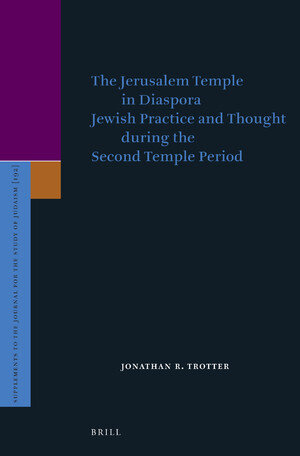Jonathan R. Trotter. The Jerusalem Temple in Diaspora: Jewish Practice and Thought during the Second Temple Period. Brill, 2019.
In recent decades, scholars of ancient Judaism have followed trends in the humanities by turning to questions of ethnicity, homeland, and identity. In The Jerusalem Temple in Diaspora, Jonathan Trotter takes on these issues by analyzing the relationship between diaspora communities and the Jerusalem temple during the late Second Temple Period. Trotter argues that diaspora communities sustained a strong connection to the temple and, by extension, their homeland, through acts of pilgrimage and monetary donation. Pilgrimage, while costly and potentially dangerous, was more widespread than most scholars have argued. Those who could not make the journey sent monetary contributions to Jerusalem, allowing them to participate in pilgrimage vicariously. Likewise, Jewish writers from the diaspora deployed temple imagery in order to strengthen the link between diaspora and homeland and to “legitimize and sanction” the existence of diaspora communities in the eyes of their Jewish and non-Jewish readers (pp. 140).
The book consists of two parts. In Chapters 1 and 2, Trotter surveys textual and epigraphic evidence for two practices undertaken by diaspora communities: pilgrimage to Jerusalem and the collection of monetary donations for the temple. He argues convincingly that both practices were more common than scholars generally believe, pointing in particular to the number of Roman sources that present the act of collecting donations for the Temple as an identifying feature of Jewish communities (e.g. Pro Flacco 28.67). In addition to allowing diaspora Jews to participate in the temple cult (directly or indirectly), Trotter argues that these practices also helped them to maintain a sense of “national identity” despite living far from Jerusalem. For pilgrims, the very act of journeying to Jerusalem, meeting other Jews, and participating in the temple cult would strengthen this identity. Those who could not make the journey participated vicariously by sending money to fund sacrifices on their behalf.
Among his major claims in this section, Trotter argues that the practices of pilgrimage and monetary donation to the temple developed during the Hasmonean period. After gaining independence, Trotter argues, the Hasmonean state would have needed to raise funds for the newly-purified temple. By encouraging diaspora Jews to visit and donate to the temple, the Hasmoneans could raise funds in the short term while also building loyalty to the temple and their state. Trotter specifically identifies the reign of John Hyrcanus (134-104 BCE) as the likely period for this development (pp. 72).
In Chapters 3-6, Trotter shifts from historical to literary analysis, examining depictions of the temple in four texts (or collections of texts) written by or to diaspora Jews: 2 and 3 Maccabees, the Letter of Aristeas, and the writings of Philo of Alexandria. Each chapter opens with a discussion of the text’s provenance, authorship, and audience, followed by a close reading and analysis of passages that relate to the temple. Readers interested in diaspora literature will appreciate the substantial and updated bibliography for each text.
The case studies in Chapters 3-6 form an extended counterargument to scholars such as Michael Tuval and Daniel Schwartz, who claim that the absence of the temple in some diaspora texts indicates that the temple was not central to life in the diaspora, at least universally. For example, Tuval attributes the marginalized role of the temple in Josephus’ Antiquities, compared to its position in War, to Josephus’ new position as a diaspora Jew (From Jerusalem Priest to Roman Jew, 2014).[1] To the contrary, Trotter argues that the temple remained a locus of devotion and a core element of Jewish identity, a claim that is persuasive when read in conjunction with the historical evidence for pilgrimage and donation to the temple in Chapters 1 and 2.
The Jerusalem Temple in Diaspora offers a reconstruction of the relationship between diaspora Jews and the temple that is both grounded in lived practices and informed by literary analysis. Trotter’s argument for the popularity of sending monetary donations to the temple is particularly compelling. Due to cost alone, pilgrimage was probably out of reach for most diaspora Jews. On the other hand, the practice of sending monetary contributions, large or small, to the temple would have been accessible to individuals across social, economic, and geographic lines. Additionally, much of the evidence for this practice comes from Asia Minor and Greece, providing additional dimension to our picture of diaspora communities that are otherwise underrepresented in literary sources.
Trotter has tackled the difficult topic of ancient Jewish identity using two sets of evidence that reflect parallel, but distinct discourses of identity: one centered in lived practices (pilgrimage and donation) and one constructed by a group of texts from the late Second Temple Period. In other words, The Jerusalem Temple analyzes both what people did to connect to the temple and what they said about it. Trotter uses these two categories of evidence to construct a cohesive picture of diaspora Judaism. The continuities between the categories that he identifies are compelling and suggest that the temple, real or imagined, was important to many circles in the diaspora. Beyond this, however, the dual analysis offered in The Jerusalem Temple invites scholars to reflect on the methods we use to reconstruct ancient identity. What does identity “look like” within different categories of evidence? How can we combine different evidence types responsibly? By assembling a rich corpus of evidence, Jonathan Trotter has thus created a point of conversation for scholars of diverse interests and training to engage with questions of identity, ethnicity, and diaspora.
[1] Michael Tuval, . From Jerusalem Priest to Roman Jew: On Josephus and the Paradigms of Ancient Judaism. WUNT 11/357 (Tübingen: Mohr-Siebeck, 2014).
Jocelyn Burney is a PhD candidate in the Department of Religious Studies at the University of North Carolina, Chapel Hill.
